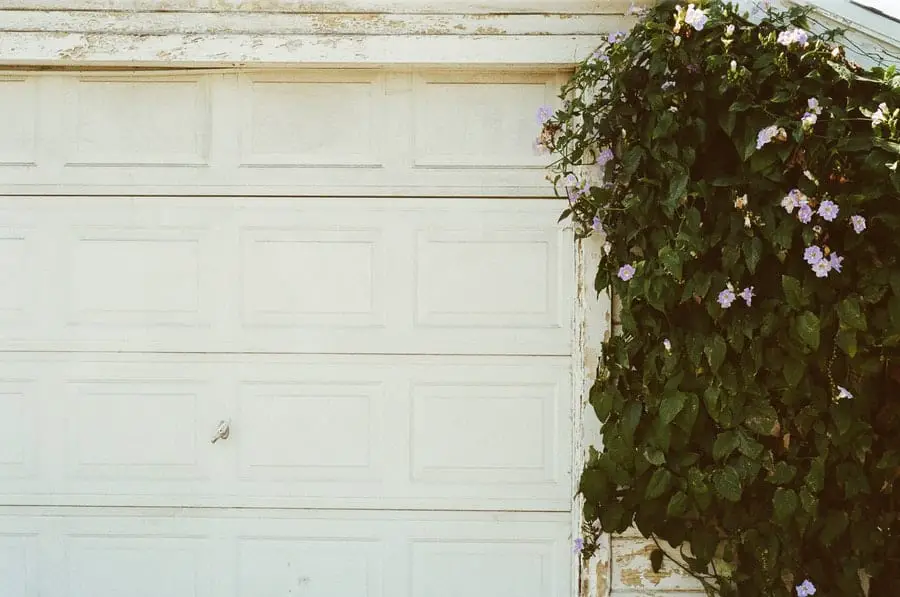Having a garage is really nice, especially if it is connected to your house. It makes stormy or cold mornings much easier and protects your car from the elements. Unfortunately, it is also one of the most common places that an intruder will gain entry to your home.
Here are some ways that you can secure your garage door
- Keep remotes inside
- Change Your Frequency
- No external keypads
- Cover windows
- Secure doors connected to the garage
- Disconnect the pull rope
- Zip tie the release
- Use motion-sensing lights
- Install an alarm
- Lock the garage door
- Use a radio
- Keep the garage door closed
Although garage doors have several weaknesses from a security standpoint, most of them are easy to overcome with a little though and very little cost. These methods will help you protect yourself, your loved ones, your stuff, and really irritate any burglar that may try to break into your home.

Keep Remotes Inside
One of the best ways to secure your garage door is to not keep any remotes in vehicles parked outside. All a burglar or home invader will need to do to gain entry to your home is bust out a window and push a button.
If you have to park a vehicle outside, be sure to take the remote inside with you. Some garage door remotes can even fit on a keychain.
Change the Opener’s Frequency
One of the first things that you should do when you buy a new home is to change the locks. This prevents any previous owners or tenants from entering your home. Changing the frequency used to open and shut the garage door with a remote will perform a similar function for your garage. This should also be done with new garage door openers and remotes.
Most garage door openers have the ability to change this frequency. How you will do this will depend on the model of your garage door opener and your remote. Finding a manual for your specific opener should be fairly easy online. You may need to purchase new “universal” remotes when you do this. Also, be sure to take a picture of its’ current settings in case you run into problems.
Avoid Using External Keypads
Another way to secure your garage door is to avoid using external keypads. Many people use codes that are very easy to figure out, and even if you use a truly random code, the numbers will still wear off. This would make it relatively easy for an intruder to figure out your code.
Cover Windows
If your garage door has windows, it is a good idea to cover them. To do this, you can frost the windows, use curtains, or cover them with some other material. Doing this will prevent potential burglars from seeing your stuff, removing temptation from their path. If the bad guy doesn’t know about your awesome toys, they won’t try to steal them.
Another benefit of covering your windows is that it prevents people from seeing if there are cars inside. This is beneficial because they will not be able to tell for certain if you are home or not. This uncertainty will make your home a less appealing target for burglars. If you have a chance to upgrade your garage door, those without windows are more secure and usually look nicer anyway.
Secure Doors Connected to the Garage
The next thing that you can do to secure a garage is to secure the doors connected to it. Any door, whether it leads inside the home or outside should be an exterior door. Exterior doors aren’t hollow, giving them more strength than flimsy interior doors.
Every door connected to a garage should also have a deadbolt installed as well. Doorknob locks are easy to defeat with a simple credit card, especially if the door is wobbly. Credit cards can’t get past a deadbolt, meaning a burglar or home invader will either have to pick the lock or kick it in. You can make doors much harder to kick in by installing a door and hinge reinforcement kit, such as the Strikemaster II.
If the door leads into the house, in addition to installing a deadbolt, add a peephole as well. This will allow you to see inside the garage without having to open the door if you are concerned there may be someone in there.
Disconnect the Pull Rope
Another way that you can secure a garage door is to disconnect the pull rope. Many times thieves will gain entry to a garage door by running a hooked clothes hanger into the crack between the garage door and the house. They will fish around until they grab the pull rope handle and then yank on it to disengage the release mechanism.
You can prevent this from happening by removing the pull rope, or at the very least, the handle. This will prevent an intruder from gaining entry in this manner, but it may make it more difficult to open your garage door during a power outage or emergency. Make sure that you fashion a tool, like a sturdy clothes hanger with a loop, to activate the release if necessary. Keep it nearby in case it is needed.
Many people worry that removing their pull rope could create a safety hazard. If this is something you are concerned about, a company called Garage Door Armor produces a device by the same name that shields your garage door’s release from attempts to tamper with it from the outside. You can read more about it by clicking here.
Zip Tie the Release
Another way that you can secure a garage door is to use a zip tie to freeze the lock the release mechanism. This will prevent a burglar or home invader from pulling on the release with a clothes hanger but will allow you to keep your pull handle intact.
You can accomplish this by running a zip tie from the main part of the release and through the release’s arm. It is important to note that the design of some garage doors may not work with this method due to the design of their emergency releases. Even with the zip tie method, I feel that removing the pull rope is still a better option.
Motion-Sensing Lights
Burglars and home invaders don’t want people to see what they are doing. Because of this, intruders, particularly home invaders, will try to gain access to your home at night. Having motion-sensing lights is a good way to secure your garage door by taking away their cover of darkness.
I prefer solar-powered motion-sensing lights or those with battery backups. This will allow your garage to remain well-lit even during power outages.
Install an Alarm
Another way that you can secure your garage door is to install an alarm. You can find standalone units or sensors that will tie into your existing home security system. They can scare intruders away, and depending on the model, possibly even send a notification to your phone.
Don’t Park Cars Too Far Forward
This next bit of advice may seem a little odd, but don’t park your cars too far forward in your garage. The reason for this your vehicle could prevent the door from caving in during a brute force breach attempt.
This sort of entry involves ramming a garage door with a vehicle with the goal of collapsing the garage door. This doesn’t happen as often as other entry methods, but it does happen occasionally. The only reason I know about it is that it nearly happened to some of my relatives.
One night, some guys in a truck rammed through the gate at the end of their driveway and then attempted to break into their home by running through the garage door with the truck. The only thing that prevented them from doing this was the tow hitch on the back of their SUV. The SUV gave structural support to the garage door and prevented it from collapsing.
Find the “sweet spot” for your car in your garage that will allow you to close the garage door with a few inches to spare. Hang a tennis ball on a string to mark this location so that you can use it as a guide. Just be sure to not shut the garage door on your car.
Lock Up the Garage Door When You Are on a Trip
A good way to secure a garage door when you are going to be gone for a while is to lock up the wheel track. You can do this by installing a garage door lock or by drilling a hole in the track that you can run a padlock or cable lock through.
When you secure your garage door in this manner, be sure to unplug it first. This will prevent you from accidentally trying to open your garage door with it locked up, which could severely damage it.
If the power goes out and you have to use the emergency release, you can use a c clamp if the door doesn’t have a lock and you don’t have time to drill a hole for a padlock. This will secure your garage door while you are gone. Just be sure to unplug the garage door opener so you don’t accidentally tear it up when you get home. (This only works if you have another way to exit the garage after you have backed the car out.)
Use a Radio
Many people like to leave their tv turned on while they are away to make potential intruders think they are home. You can do the same thing with a radio in your garage. The sound of a radio will create enough uncertainty in most criminals’ minds that they will pick another house to target just to be safe.
Keep the Garage Door Closed
While this may be common sense, the best way to secure your garage door is to not leave it open. No matter how many security features you may have, leaving your garage door open makes them all useless.
I am surprised at how many people regularly leave their garage door open, giving a potential intruder a clear path into their home. Even if the door leading into the house is locked, all the burglar or home invader has to do to conceal their actions is shut the garage door. This will conceal them, giving them more time to break-in.
